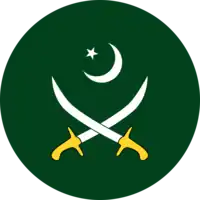Talat Masood
Lieutenant-General Talat Masood (Urdu: طلعت مسعُود); HI(M), SBt,:1–9[2] is a retired three-star rank army general, a political commentator, and a mechanical engineer.[3]
Talat Masood | |
|---|---|
| Birth name | Talat Masood |
| Nickname(s) | Gen. Masood |
| Born | British India (Present-day in India and Pakistan.) |
| Allegiance | |
| Service/ | |
| Years of service | 1950–90 |
| Rank | |
| Service number | PA No.–3894:10[1] |
| Unit | Pakistan Army Corps of EME |
| Commands held | Federal Secretary to MoDP Chairman POF Heavy Industries Taxila |
| Battles/wars | Indo-Pakistani War of 1965 Indo-Pakistani War of 1971 |
| Awards | |
| Other work | Columnist, Commentator |
His career in the military spent in the Pakistan Army Corps of EME as an engineering officer and also served as the Federal Secretary at the Ministry of Defence Production of Government of Pakistan.[4] He is noted for his analysis on the global national security, economic stability, and often consults on politics on the national and international media networks.[5]
Biography
Talat Masood joined the Pakistan Military Academy, and was educated at the Military College of Engineering where he graduated with a B.S. in mechanical engineering.:contents[6]
In 1951, he gained commission in the Corps of EME, where his career in the army is mostly spent.[7][8] In 1951–54, 2nd-Lt. Masood was one of the few army officers who were sent to the United Kingdom to attend the Loughborough University where he did the post-graduate studies.:365[9] He gained M.S. in mechanical engineering from the Loughborough University and joined the Pakistan Ordnance Factories for evaluation of fire arms and weapons accuracy.:365[9]
He attended the Command and Staff College in Quetta where he qualified as a psc, and later went attended the National Defence University (NDU) where he gained MSc in defence studies.:10[1][3]
He participated in the conflicts and wars with India in 1965 and in 1971, but his career mostly spent in the local defense production.:31[10] About the aerial operations by PAF, Masood is of the view that: "The mobility, even the survivability of land forces depended to a large extent on air cover, so does the naval security. Superior air power is thus vital for any military engagement.":169[11]
In 1970s, he served as the chairman of the Heavy Industries Taxila (HIT), where he was involved in the design and development of the various military vehicles and the technology evaluation of the main battle tanks.:xviii[12]
In 1980s, he was appointed as chairman of the Pakistan Ordnance Factories (POF), where he is credited of bringing the fire-arm manufacturing organization to its peak of efficiency especially the manufacturing of the chemical explosives.:109[13]:contents[14] In 1988–89, he was involved in the technology transfer of the Mirage III at the Pakistan Aeronautical Complex, and witnessed the induction of the aircraft to the UAE Air Force.[15]
In 1988, Lt-Gen. Masood joined the Benazir administration when he appointed as the secretary of defense production, which he served until he retired from his military service with the army in 1990.:x[6]
Post-retirement activities
After his retirement in 1990, Masood became a political consultant to several important U.S. think tanks and technology firms.[5]
He writes and opined regularly on political and security issues in English-language newspapers in Pakistan and foreign political correspondents.[16] In November–December 1997, he was appointed as visiting fellow at the Stimson Center in Washington DC in the United States where his research topic included the discussion and rational on "nuclear weapons issues in the subcontinent."[17]
Since 2013, Masood is on Council of Pugwash Conferences on World Affairs.[18]
Notes
- The Gazette of Pakistan. Govt. of Pakistan. 1980. Retrieved 12 November 2017.
- Hilāl (in Urdu). Inṭar Sarvisiz Pablik Releshanz Dāʻirikṭreṭ. 1986. Retrieved 12 November 2017.
- "Lt. Gen (R) Talat Masood". Pakistan Herald. Pakistan Herald. Retrieved 11 November 2017.
- "Lt.-Gen. (Ret.) Talat Masood". Global Zero. Global Zero. Retrieved 11 November 2017.
- "Lieutenant General Talat Masood - Jamestown". Jamestown. Retrieved 11 November 2017.
- Lodgaard, Sverre; Maerli, Bremer (2007). Nuclear Proliferation and International Security. Routledge. ISBN 9781134110001. Retrieved 11 November 2017.
- "Profiles: International Conference on Civil-Military Relations". www.pildat.org. PILDAT. Retrieved 11 November 2017.
- ICCMR, International Conference on Civil Military Relations (1990), See:Lt. Gen. (Retd.) Talat Masood, Former Federal Secretary, retrieved 1 June 2010
- Development, Centre for Research in Rural and Industrial (2004). The vitality of India. New Dehli, India: Centre for Research in Rural and Industrial Development. p. 366. ISBN 9788185835471. Retrieved 11 November 2017.
- Copley, Gregory R. (1989). Defense & Foreign Affairs Strategic Policy. Copley & Associates. Retrieved 11 November 2017.
- Siddiqa-Agha, A. (2001). "Arms procurement for the Air Force". Pakistan's Arms Procurement and Military Buildup, 1979-99: In Search of a Policy (google books). London, Uk: Springer. p. 220. ISBN 9780230513525. Retrieved 11 November 2017.
- Farooq, Nasra Talat (2016). US-Pakistan Relations: Pakistan’s Strategic Choices in the 1990s. Routledge. ISBN 9781317358497. Retrieved 11 November 2017.
- Cloughley, Brian (2008). War, Coups & Terror: Pakistan's Army in Years of Turmoil (2 ed.). Skyhorse Publishing Inc. p. 109. ISBN 9781602396982. Retrieved 11 November 2017.
- Cloughley, Brian (2016). A History of the Pakistan Army: Wars and Insurrections. Skyhorse Publishing, Inc. ISBN 9781631440397. Retrieved 11 November 2017.
- Farooq, PAF, AVM Umar. "DGPAC Kamra – Air Vice Marshal (R) Farooq Umar". avmfarooqumar.com. avm umar farooq. Retrieved 11 November 2017.
- "talat.masood, Author at The Express Tribune". The Express Tribune. Retrieved 11 November 2017.
- "South Asia Visiting Fellows Program". Stimson Center. Retrieved 11 November 2017.
- "Talat Masood". Pugwash Conferences on Science and World Affairs. 6 November 2013. Retrieved 11 November 2017.

